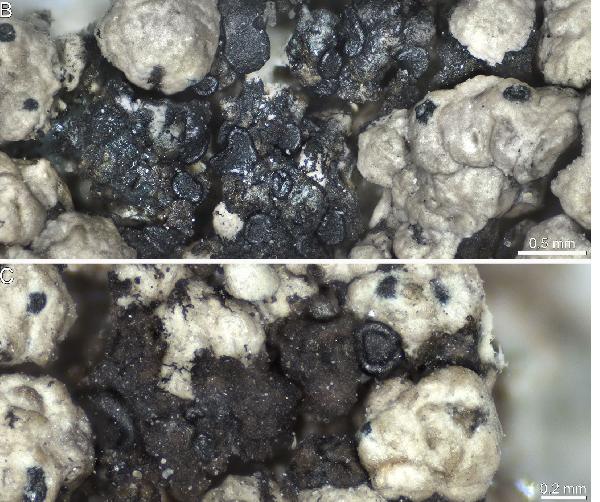Carbonea tephromelae M.Svensson & M.Westb.
Phytotaxa, 522, 3: 225, 2021
Synonyms:
Description: Thallus crustose, indistinct, consisting of inconspicuous, dull-brown, flat flecks containing cells of a green alga, partly delimited by a black prothallus along the edges, causing the formation of 2-10 mm wide, somewhat depressed areas on the thallus of Tephromela atra. Apothecia glossy black, sessile, lecideine, not confluent but agglomerated in scattered clusters of 5-20(-40) along the edges of the host areoles, 0.2-0.4(-0.5) mm across, with a mostly flat disc and a more or less flexuose proper margin which is initially slightly raised, then often level with disc. Proper exciple black, carbonized, c. 20–45(–85) µm thick, of radiating, thick-walled hyphae with c. 2 µm wide lumina; epithecium blue-green, N+ purple-red, K-; hymenium colourless in lower part, blue-green in upper part, 50-75 µm high; paraphyses coherent, simple or forked in uppermost part, often slightly constricted at septa, c. 1.5 µm thick at mid-level, the apical cells 1.5–2.5 µm wide; hypothecium almost colourless (extra-median sections may give the impression of a dark-brown hypothecium!), without crystals. Asci 8-spored, clavate, the K/I+ blue tholus penetrated by a faintly amyloid apical cushion with parallel or diverging flanks, the outer wall very thin, K/I-, surrounded by a K/I+ blue outer layer, Lecanora-type. Ascospores 1-celled, hyaline, broadly ellipsoid to subglobose, 7.5-11 x (5-5-)6-8(-8.5) μm, 1-1.5 times as long as wide. Photobiont chlorococcoid. Spot tests: thallus K-, C-, KC-, P-, UV-. Chemistry: without lichen substances.
Growth form: Crustose
Substrata: rocks
Photobiont: green algae other than Trentepohlia
Reproductive strategy: mainly sexual
paras Tephromela atra
Commonnes-rarity: (info)
Alpine belt: very rare
Subalpine belt: absent
Montane belt: absent
Dry submediterranean belt: absent
Humid submediterranean belt: absent
Padanian area: absent
pH of the substrata:
1 2 3 4 5
Solar irradiation:
1 2 3 4 5
Aridity:
1 2 3 4 5
Eutrophication:
1 2 3 4 5
Poleotolerance:
0 1 2 3
Altitudinal distribution:
1 2 3 4 5 6
Rarity
absent
extremely rare
very rare
rare
rather rare
rather common
common
very common
extremely common
Loading data...
Occurrence data
Predictive map

Walter Obermayer
Carbonea tephromelae on Tephromela atra: three different infections,
all from the same specimen (leg. J. Poelt et al., 22.VII.1981). – A–B) Infected
areas with thallus and apothecia of Carbonea tephromelae. – C) Close-up of
young infection showing the dull brown thallus and one apothecium of
Carbonea tephromelae. The black roundish patches on the whitish
Tephromela areoles are ostiolar regions of host pycnidia
Growth form: Crustose
Substrata: rocks
Photobiont: green algae other than Trentepohlia
Reproductive strategy: mainly sexual
paras Tephromela atra
Commonnes-rarity: (info)
Alpine belt: very rare
Subalpine belt: absent
Montane belt: absent
Dry submediterranean belt: absent
Humid submediterranean belt: absent
Padanian area: absent
pH of the substrata:
| 1 | 2 | 3 | 4 | 5 |
Solar irradiation:
| 1 | 2 | 3 | 4 | 5 |
Aridity:
| 1 | 2 | 3 | 4 | 5 |
Eutrophication:
| 1 | 2 | 3 | 4 | 5 |
Poleotolerance:
| 0 | 1 | 2 | 3 |
Altitudinal distribution:
| 1 | 2 | 3 | 4 | 5 | 6 |
Rarity
absent
extremely rare
very rare
rare
rather rare
rather common
common
very common
extremely common
Loading data...
Occurrence data
Predictive map







